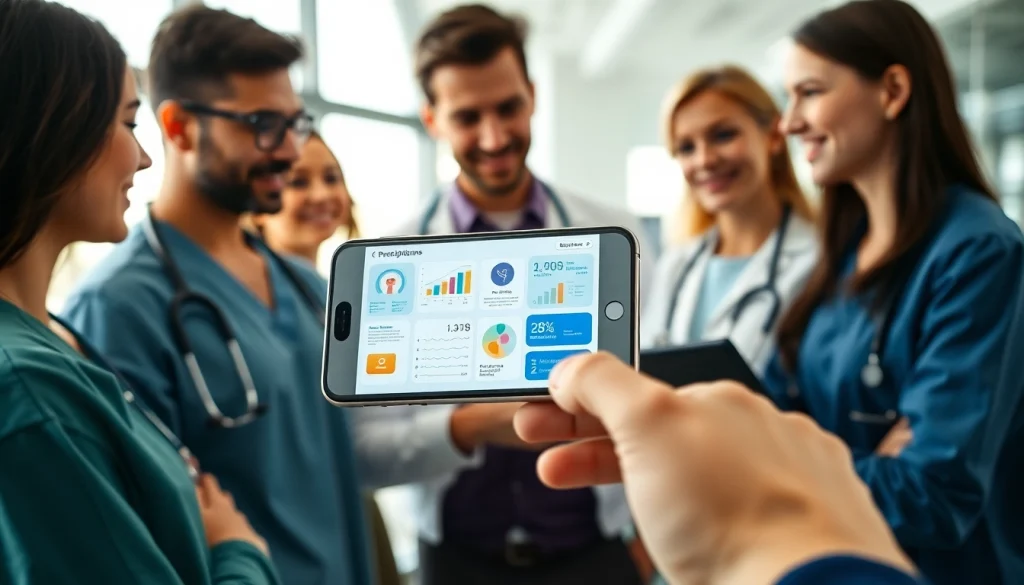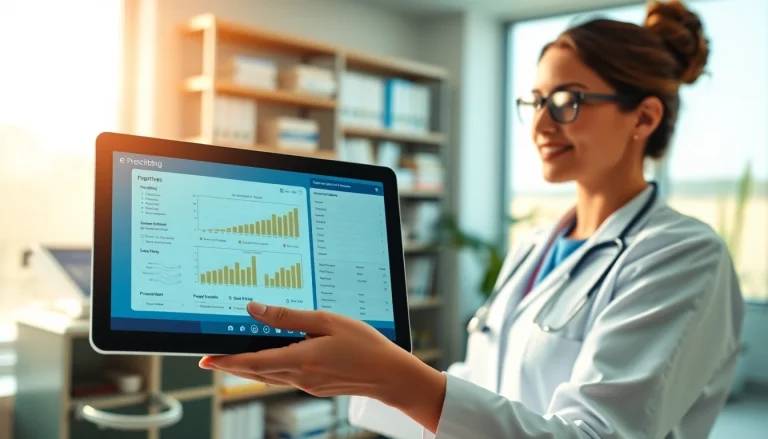
The Importance of Top Rated Prescription Applications
In today’s fast-paced healthcare environment, efficiency and accuracy in medication management are paramount. The rise of technology in healthcare, including top rated prescription applications, has significantly revolutionized how patients and providers interact with prescriptions. These applications not only streamline the prescribing process but also enhance patient safety by reducing errors and ensuring compliance with treatment protocols. Understanding the importance of these applications is essential for both healthcare professionals and patients seeking to optimize their healthcare experience.
Understanding User Needs and Intent
At the core of any effective application are the users and their unique needs. For patients, the primary intent is to manage their medications effectively, including obtaining prescriptions, scheduling refills, and ensuring adherence to therapies. Healthcare providers, on the other hand, require tools that assist in patient management, enable accurate prescribing, and facilitate communication with pharmacies.
The ability to understand and align with these diverse user needs plays a crucial role in the design and functionality of top rated prescription applications. For instance, applications that incorporate user feedback can continually evolve to meet the changing demands of both patients and healthcare providers.
Impact on Medication Management
Effective medication management is critical in preventing adverse drug events and ensuring optimal therapeutic outcomes. Top rated prescription applications contribute significantly to this endeavor. They provide functionalities such as medication reminders, drug interaction alerts, and educational resources about medications, thereby empowering patients to take an active role in their health.
Moreover, these applications facilitate more organized medication regimens. Patients can track what medications they need to take and when, which reduces the likelihood of missed doses or incorrect dosages. For healthcare providers, the ability to prescribe through digital platforms enables real-time adjustments based on patient progress, contributing to a more dynamic approach to healthcare.
Trends in Healthcare Technology
The healthcare technology landscape is undergoing rapid transformation, with several emerging trends shaping the future of prescription applications. One prominent trend is the integration of artificial intelligence (AI) and machine learning, which enhances the predictive capabilities of these applications, allowing for better personalization and efficiency.
Additionally, the rise of telemedicine has highlighted the need for seamless integration between prescription applications and virtual consultations. As more patients engage in remote healthcare services, having a smooth transition from virtual prescribing to medication management becomes essential.
Key Features of Top Rated Prescription Applications
User-Friendly Interfaces
A significant factor that determines the success of any application is its usability. Top rated prescription applications are designed with user-friendly interfaces that simplify navigation and enhance the user experience. Features such as intuitive layouts, clear instructions, and easy access to essential functions can greatly affect how effectively users interact with the application.
Moreover, these applications often incorporate visual aids and interactive elements to guide users through complex tasks, ensuring that even those with minimal tech experience can utilize them effectively. A user-centric approach in design leads to greater adoption rates and improved outcomes.
Integration with Health Records
Integration with electronic health records (EHR) is a defining feature of top rated prescription applications. It allows for seamless information sharing between providers, patients, and pharmacies, thus enhancing communication and coordination of care. By accessing a patient’s complete medical history, providers can make informed prescribing decisions that consider potential allergies, previous medications, and existing conditions.
Such integration also minimizes the potential for errors and enhances the overall safety of the prescribing process. Additionally, it enables patients to have a comprehensive view of their health information, fostering better engagement in their own care.
Real-Time Data and Alerts
Real-time data capabilities and alerts are crucial features in enhancing the effectiveness of prescription applications. These features allow for up-to-date tracking of patient adherence and provide notifications for medication refills or dosage reminders. This constant communication helps healthcare providers identify potential issues promptly and intervene as necessary.
Furthermore, alerts for drug interactions and contraindications serve as an additional safety net, protecting patients from harmful medication combinations. Overall, these real-time features contribute to better medication management and improved patient safety.
Evaluating Top Rated Prescription Applications
Criteria for Selection
When evaluating top rated prescription applications, several criteria are essential to ensure that they meet the needs of users effectively. These criteria include functionality, usability, security, integration capabilities, and overall effectiveness in improving medication management.
Functionality refers to the core features that support comprehensive medication management. Usability focuses on the user interface and ease of use. Security is paramount, especially regarding patient data protection, requiring adherence to regulatory standards such as HIPAA. Integration capabilities and the application’s effectiveness in enhancing medication management are also key determinants of its success.
User Reviews and Ratings
User reviews and ratings provide valuable insights into the performance and satisfaction levels associated with prescription applications. Analyzing feedback from users can reveal common pain points, highlight successful features, and identify areas for improvement. Consumers today often rely on reviews as a form of validation before adopting new technologies, making this an essential aspect of the evaluation process.
High ratings typically indicate that an application meets its promises regarding ease of use, functionality, and user experience. Therefore, it’s vital for developers to monitor and respond to user feedback actively, fostering a sense of trust and community around their applications.
Case Studies of Successful Implementations
Examining case studies of successful implementations of prescription applications can provide empirical evidence of their effectiveness. These case studies often highlight specific challenges faced by healthcare organizations and how the applications addressed those challenges.
For instance, a hospital that implemented a prescription application may report significant reductions in medication errors or improvements in outpatient follow-up rates. These success stories not only serve as inspiration for others considering similar applications but also provide practical insights into best practices and operational strategies that work.
Best Practices for Utilizing Top Rated Prescription Applications
Training Healthcare Professionals
One of the critical steps in successfully deploying top rated prescription applications is ensuring that healthcare professionals receive adequate training. Comprehensive training programs should focus on the application’s functionalities, best practices for patient engagement, and navigating potential challenges.
Moreover, ongoing training should be provided to keep healthcare professionals updated on new features and enhancements, fostering a culture of continuous improvement and optimal use of the applications. This investment in training translates into better patient outcomes and greater adherence to prescribed therapies.
Ensuring Patient Engagement
Creating a patient-centered approach is essential in utilizing prescription applications effectively. Engaging patients means providing them with the tools and resources they need to take an active role in their health. This can involve targeted communication strategies, educational materials about their medications, and personalized alerts regarding adherence.
Furthermore, applications should have features that encourage patients to provide feedback and share their experiences. This feedback loop not only aids in the ongoing design and enhancement of the application but also fosters a sense of empowerment in patients regarding their health.
Maintaining Compliance and Security
Maintaining compliance with healthcare regulations and ensuring the security of sensitive patient data are paramount in the design and utilization of prescription applications. Developers must prioritize data protection by incorporating robust security measures, including encryption, secure authentication protocols, and regular security audits.
Additionally, healthcare organizations should implement strict policies regarding data access and usage, ensuring that only authorized personnel can access sensitive information. By prioritizing compliance and security, organizations can enhance trust and confidence in the prescription applications they employ.
The Future of Top Rated Prescription Applications
Evolving Technologies in Healthcare Apps
The future of top rated prescription applications is poised to be shaped by innovative technologies and patient-centric trends. Emerging technologies such as artificial intelligence, big data analytics, and the Internet of Things (IoT) are expected to revolutionize how medications are prescribed and managed.
AI-driven insights will enable more personalized treatment suggestions, while big data will allow for predictive analytics that can foresee potential treatment challenges. IoT devices will facilitate real-time tracking of adherence and health metrics, providing a more comprehensive view of patient health.
Potential Challenges Ahead
Despite the promising future, challenges remain in the widespread adoption of prescription applications. One significant challenge is the digital divide, wherein some patient populations may lack access to the necessary technology or digital literacy to utilize these applications effectively.
Additionally, ensuring interoperability between different healthcare systems poses a challenge for seamless data exchange, which is critical for comprehensive medication management. Addressing these challenges through targeted strategies and inclusive policies will be necessary for maximizing the benefits of prescription applications.
Looking Towards Innovation and Improvement
As the healthcare landscape continues to evolve, there is an ongoing need for innovation and improvement in top rated prescription applications. Developers, healthcare professionals, and patients must work collaboratively to identify gaps in functionality, usability, and patient engagement.
Continuous research and development will lead to enhanced features, better user experiences, and the potential for novel applications that further improve medication management. With a shared vision of optimizing healthcare through technology, the future of prescription applications holds great promise.






